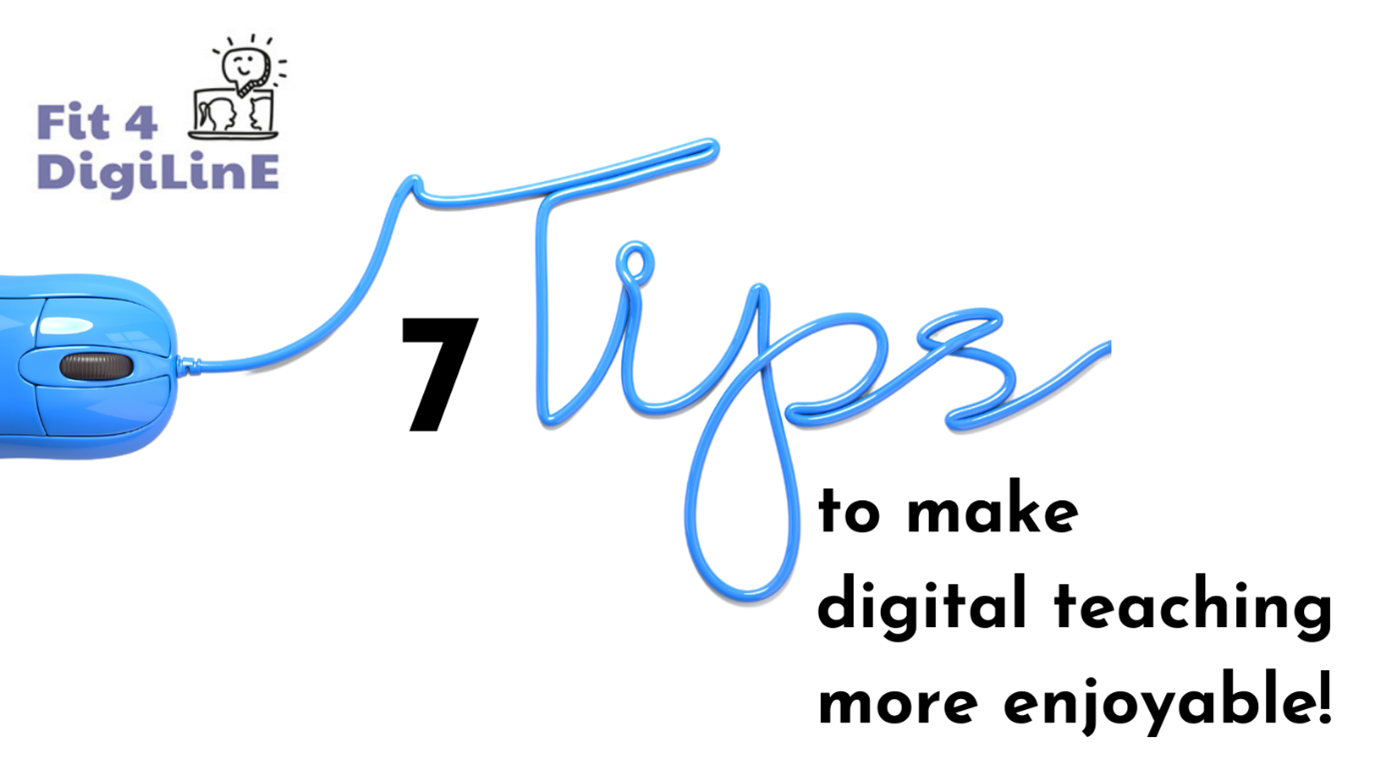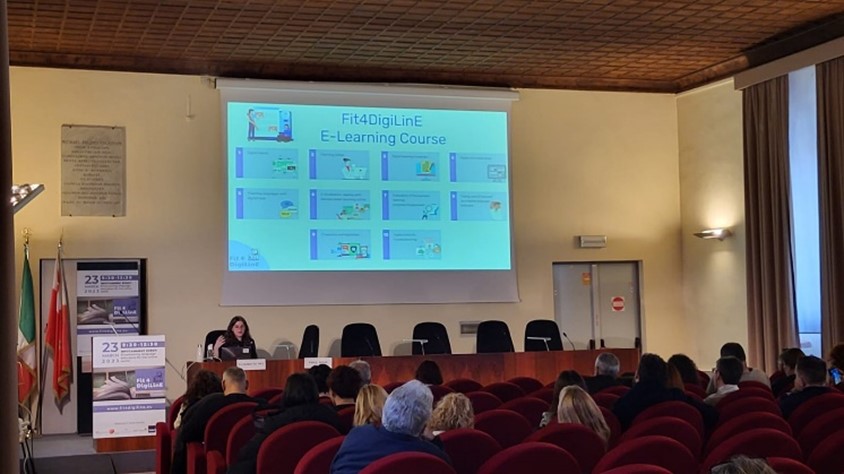Whenever we are in the middle of a project it is easy to lose sight of the bigger picture. Halfway through the school year and at the end of 2021, we are happy to share with you 7 TIPS TO MAKE DIGITAL TEACHING MORE ENJOYABLE and hope to provide some fresh ideas and motivation.
1. Arrange your desk
When teaching online, it is easy to get lost in your notes, emails, and to-do lists and as your workload increases so probably does the disorganization on your desk. Therefore, if you wish to improve your workflow, start with the arrangement of your desk. Make it your home base, your place of well-being. A functional workplace is not only appealing because of its neatness but also through its aesthetics. It may mean some effort in the beginning, but it will bring you more ease of use, structure, and peace of mind.
Tip 1: Divide your desk into areas and label them, e.g., “writing tools”, “books and materials”, “games”, “last minute ideas”, … This way you will always know where something goes or where to find it.
TIP 2: Put an object on your desk that empowers you. Maybe a souvenir from your most memorable holiday? Or a little token that reminds you of a special moment? Put it where you can easily see it. A glance at it will surely lift your spirit during your online classes. Try it out!
You can find more ideas on how to declutter your workspace here: https://www.roberthalf.com/blog/salaries-and-skills/how-to-organize-your-desk-for-maximum-efficiency
2. Choose something special to look forward to
Teaching online can be exhausting and motivation can diminish as the day goes on. A simple technique to inspire you before starting your day is thinking of a moment you’re looking forward to. Maybe it’s a warm bath (in winter) or a refreshing swim in a lake (in summer); a good book, a meeting with friends or an invitation to a homecooked dinner.
TIP: Before starting your online lesson, close your eyes and imagine with all your senses what is lying ahead. Remember – it’s those little things that can carry you through a tough day! They will put you in the positive mood you need to deal with your students, handle difficulties and do your best!
You can find more motivational techniques here: https://contentmentquesting.com/10-powerful-self-motivation-techniques/
3.Think about your posture and good lighting
Would you agree that the way you sit can change how you feel while working? Yes? Maybe? And would you also agree that the lighting of your face during your online classes has an impact on you and the people watching you on screen?
Try to feel the difference: Leaning back in your chair or sitting upright without leaning against the back of your chair. Which one feels better suited for teaching? The first may be more comfortable, but certainly limits your range of movements and might make you look overly casual. The latter allows you to be more active and alert to your students.
Also try changing your light source! Where possible use natural light and make sure to avoid harsh lighting. You may also want to consider using a video filter. Well-balanced lighting makes a huge difference in video calls since it literally shows you in a positive light.
TIP 1: Sit upright without leaning backwards, sitting only on the first third of your seat surface. This may sound uncomfortable, but it gives you some huge benefits: you are more present to your students; you are more attentive and alert; you have a broader range of movements; you feel agile and empowered.
TIP 2: Consider different light sources and find a suitable video filter.
Find out more about the right lighting during video calls here: https://www.youtube.com/watch?v=rGcAM1CNEU0
4. Remember the rules
Let’s take a moment to appreciate what rules can do for us in the online classroom: they give clear guidelines; they spell out what kind of behavior we expect from each other and they create a respectful work environment for all participants. Great, right? At the beginning of your online language course, you have probably already set rules that everybody agreed on. That is very useful for everyone! However, students tend to forget about the rules over time. So, how about a friendly reminder every now and then?
TIP: Take a moment to visualize the rules and talk about them in class in a positive, respectful way, providing examples of the benefits they bring. For instance, you may want to remind students of a quiet environment at home to eliminate distractions.
You can find some useful tips on rules in learning groups here: https://susanfitzell.com/strategies-for-effective-group-processes-establish-ground-rules/
5. Less is more
At times preparing an online lesson can be overwhelming. There are countless tools, games and websites that promise to be the perfect addition for your online language lesson. On some days even the most handy online tool can be stressful if you are neither fully comfortable with it nor fully competent to use it or if there are other challenges during your lesson. So be kind to yourself and don’t overdo it by switching between 10 different tools in 45 minutes. Keep in mind that “less is more”.
TIP: Set yourself a limit of tools and websites you want to use in each of your lessons. Choose wisely and pick those you know well, and which support your teaching strategy. Ensure that they work for you as well as your students. In time you will enlarge your repertoire and use it effectively in your classes. But remember it’s quality not quantity that makes a good lesson. Often it is better to use only a few tools, but they are then perfect for the activities you planned for your students.
Find a list of our (LINK TO Good Practices Digital Tools and Learning Methods for Digital Language Teaching) Good Practices Digital Tools and Learning Methods for Digital Language Teaching here.
6. Try to integrate your online and offline environment
Nowadays everything is online: your yoga class, your supermarket, your colleagues, and your students. But don’t forget that even if you do many things online, you are still surrounded by an offline environment and you have offline (learning) habits. So, don’t exclude offline teaching ideas from the outset, but rather think outside the box and try to find a way to integrate them effectively into your digital teaching.
TIP: Use your offline surroundings in your online courses and ask your students to do so, too! Let them grab one of their most beautiful belongings (or alternatively one of the most dreadful), an object that they recently acquired or something that has been in their possession for a long time, then ask them to describe those items to the others. Make them look out of their window and describe what they see. You could also ask your students to give a description of something they see in the room they sit in while the others have to draw it on a piece of paper. And why not let them throw dice and every number corresponds to a question? – Feel free to come up with your own ideas to integrate the real world in your online teaching!
7. Be dynamic
We already explained that it is not the quantity of tools you use that makes a good online lesson. Part of what makes teaching effective is varying the classroom organization (or social forms). We recommend you avoid constant front-of-the-class teaching but rather allow for interaction. Make your classes more dynamic by choosing team-based, group-based, or pair-based activities. There are a lot of options to choose from: talking to a partner, working in pairs, and presenting your results in front of the whole group, working in groups of four and exchanging ideas with another group, …
TIP: Be dynamic, create interactive lessons and allow exchange among your students. Vary the way your students get their input and use all the technical options at your disposal, such as breakout rooms and more.
We hope we could give you some inspiration with our 7 TIPS TO MAKE DIGITAL TEACHING MORE ENJOYABLE! Which one will you integrate first in your digital lessons? Stay in touch to get more information about our project and lots of helpful ideas to increase your competence in digital language teaching!




